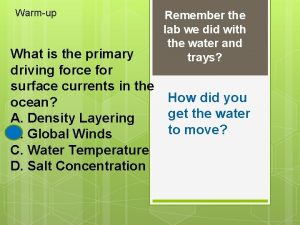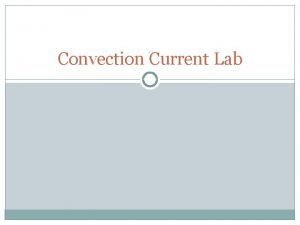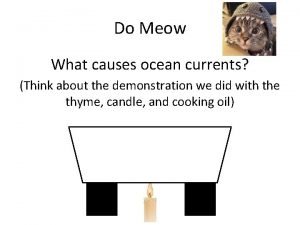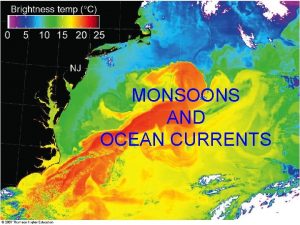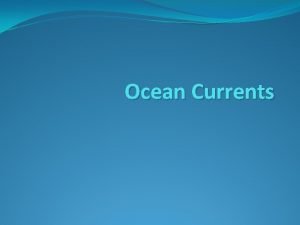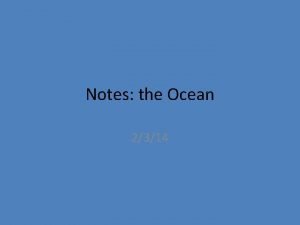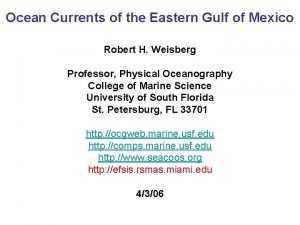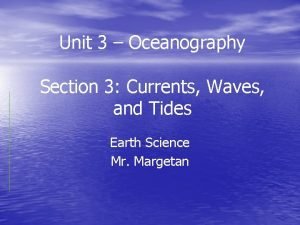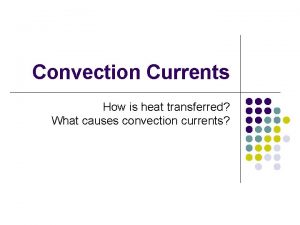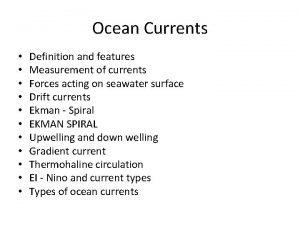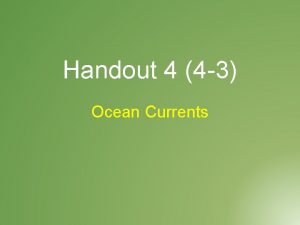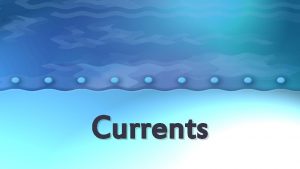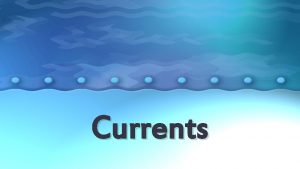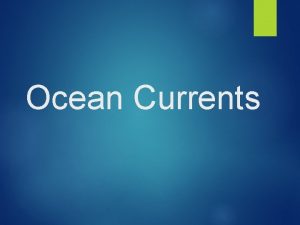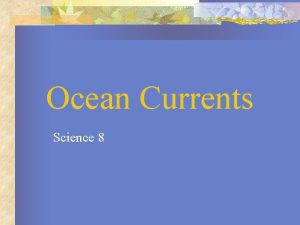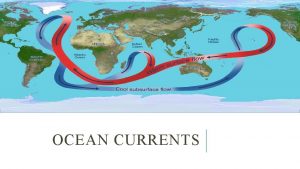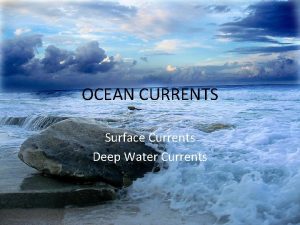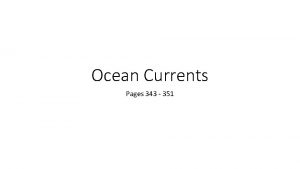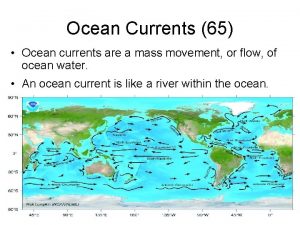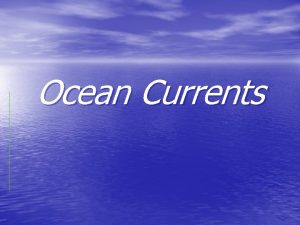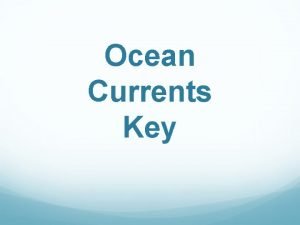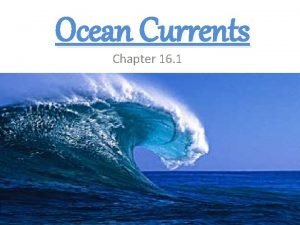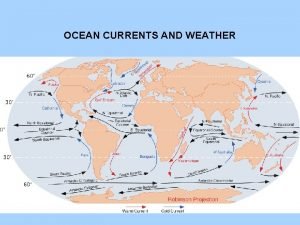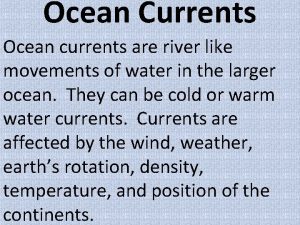Ocean Currents The Reality of Sending a Message

















- Slides: 17

Ocean Currents The Reality of Sending a Message in a Bottle

Ocean Current Layers n n n Surface Currents – upper 10% of the ocean; upper 400 m Pycnocline – the layer between surface and deep waters; where a rapid change in temperature, salinity and density occur Deep Current – lower 90% of the ocean

Ocean Water Properties n How they impact ocean currents • Temperature – remember heat rises! • Salinity – remember salty water sinks! • Density – a function of temperature and salinity

Ocean Surface Temperatures http: //www. bigelow. org/shipmates/sstemp_lg. gif

Temperature vs. Currents http: //earth. usc. edu/~stott/Catalina/Oceans. html

Ocean Surface Salinities http: //www. bigelow. org/shipmates/salinity_lg. gif

Ocean Density http: //www. windows. ucar. edu/tour/link=/earth/Water/density. html&edu=high

Primary Current Forces n These Start the Water MOVING: • Solar Heating • Winds • Gravity • Coriolis Force/Effect

Current Forces Explained n n n Sun/solar heating - causes water to expand move Winds - push the water; winds blowing for 10 hrs across ocean will cause the surface water to flow @ ~2% wind speed; wind has the greatest effect on surface currents Gravity - pull water downhill or pile against the pressure gradient (high/low); influences tides

Winds http: //www-earth. usc. edu/~stott/Catalina/Oceans. html

Wind Driven Ocean Currents http: //www. bigelow. org/shipmates/hc_currents_lg. gif

Current Influences (cont’d) n Coriolis effect/force - Force due to the Earth's rotation, capable of generating currents. It causes moving bodies to be deflected to the right in the Northern Hemisphere and to the left in the Southern Hemisphere. The "force" is proportional to the speed and latitude of the moving object. It is zero at the equator and maximum at the poles http: //www. csc. noaa. gov/text/glossary. html n causes the water to move around the mound of water

Surface Currents n Surface current – with surface circulation is less dense and influenced by winds 1. Warm surface currents: wind and Earth’s rotation 2. Cold surface currents: flow towards the equator 3. Upwelling current: cold, nutrient rich; result of wind 4. Western Boundary currents: warm & fast 5. Eastern Boundary currents: broad, slow, cool & shallow, associated with upwelling n Ex: Gulf Stream = surface current that is the upper 20% of the ocean, western boundary current

Deep Currents n Deep water – cold, dense, salty; move by density forces and gravity; move slower than layers above • Thermohaline Circulation: is global ocean circulation. It is driven by differences in the density of the sea water which is controlled by temperature (thermal) and salinity (haline). In the North Atlantic it transports warm and salty water to the North. There the water is cooled and sinks into the deep ocean. This newly formed deep water is subsequently exported southward. This slow (~0. 1 m/s), but giant circulation has a flow equal to about 100 Amazon Rivers. Together with the Gulf Stream it contributes to the comparatively warm sea surface temperature along the coast of western Europe and to the relative mild European winters. Once the water are in the deep, they remain there for up to 1000 years. http: //www. climate. unibe. ch/~christof/div/fact 4 thc. html n Ex: Global Conveyer Belt = deep current that is the lower 20% of the ocean; takes 1, 000 years to complete the cycle

Global Conveyer Belt n Thermohaline circulation links the Earth's oceans. Cold, dense, salty water from the North Atlantic sinks into the deep and drives the circulation like a giant plunger. http: //www. columbia. edu/cu/record/23/11/13. html Graphic - http: //www. grida. no/climate/vital/32. htm

Other Currents n n Gyres – large mounds of water; large circular currents in the ocean basin Ex: North Atlantic Gyre = consists of 4 separate currents – N. Equatorial, Gulf Stream, N. Atlantic Drift and Canary Currents

Ocean Currents & Living Things n Currents are important to marine life as they help move food and nutrients making them available for photosynthesis, metabolic requirements and or consumption.
 What is deep current
What is deep current What is the primary driving force of surface-ocean currents
What is the primary driving force of surface-ocean currents Convection currents in the ocean
Convection currents in the ocean What are ocean currents
What are ocean currents Ocean currents
Ocean currents Ocean currents waves and tides
Ocean currents waves and tides Rubber ducks ocean currents activity
Rubber ducks ocean currents activity Why are tropical climates so hot brainpop
Why are tropical climates so hot brainpop Factors affecting their climate
Factors affecting their climate Cenozoic mammals
Cenozoic mammals Coriolis effect vocabulary
Coriolis effect vocabulary What are ocean currents
What are ocean currents Ocean currents gulf of mexico
Ocean currents gulf of mexico Midnight zone
Midnight zone Ocean currents
Ocean currents A. what causes convection currents?
A. what causes convection currents? Ocean currents definition
Ocean currents definition Surface ocean currents
Surface ocean currents

